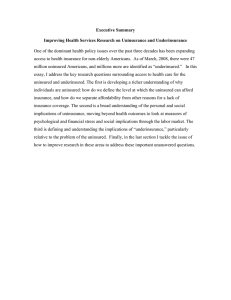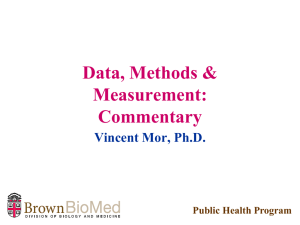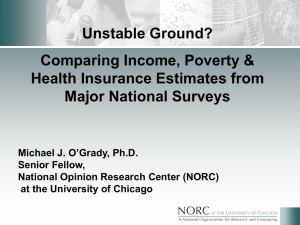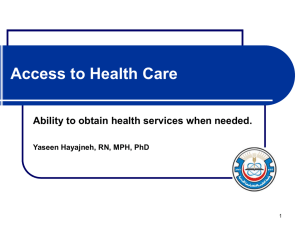Why Health Insurance Is Important
advertisement
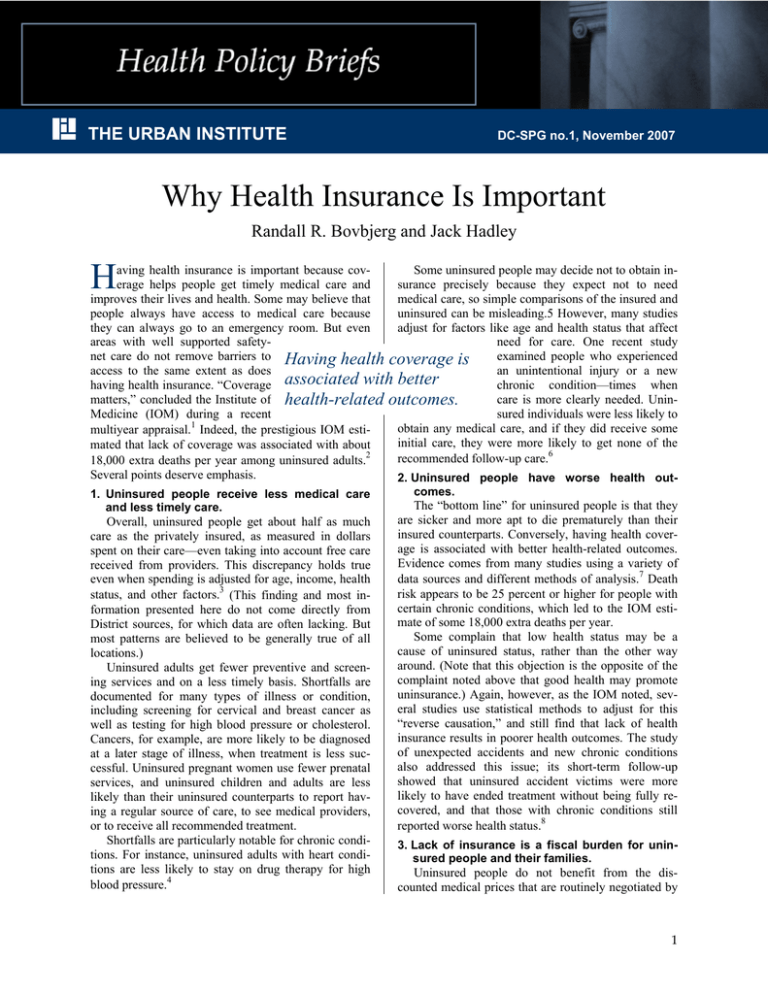
Health Policy Brief Importance of Insurance THE URBAN INSTITUTE DC-SPG no.1, November 2007 Why Health Insurance Is Important Randall R. Bovbjerg and Jack Hadley H Some uninsured people may decide not to obtain inaving health insurance is important because covsurance precisely because they expect not to need erage helps people get timely medical care and medical care, so simple comparisons of the insured and improves their lives and health. Some may believe that uninsured can be misleading.5 However, many studies people always have access to medical care because adjust for factors like age and health status that affect they can always go to an emergency room. But even need for care. One recent study areas with well supported safetyexamined people who experienced net care do not remove barriers to Having health coverage is an unintentional injury or a new access to the same extent as does chronic condition—times when having health insurance. “Coverage associated with better care is more clearly needed. Uninmatters,” concluded the Institute of health-related outcomes. sured individuals were less likely to Medicine (IOM) during a recent obtain any medical care, and if they did receive some multiyear appraisal.1 Indeed, the prestigious IOM estiinitial care, they were more likely to get none of the mated that lack of coverage was associated with about recommended follow-up care.6 18,000 extra deaths per year among uninsured adults.2 Several points deserve emphasis. 2. Uninsured people have worse health out1. Uninsured people receive less medical care and less timely care. Overall, uninsured people get about half as much care as the privately insured, as measured in dollars spent on their care—even taking into account free care received from providers. This discrepancy holds true even when spending is adjusted for age, income, health status, and other factors.3 (This finding and most information presented here do not come directly from District sources, for which data are often lacking. But most patterns are believed to be generally true of all locations.) Uninsured adults get fewer preventive and screening services and on a less timely basis. Shortfalls are documented for many types of illness or condition, including screening for cervical and breast cancer as well as testing for high blood pressure or cholesterol. Cancers, for example, are more likely to be diagnosed at a later stage of illness, when treatment is less successful. Uninsured pregnant women use fewer prenatal services, and uninsured children and adults are less likely than their uninsured counterparts to report having a regular source of care, to see medical providers, or to receive all recommended treatment. Shortfalls are particularly notable for chronic conditions. For instance, uninsured adults with heart conditions are less likely to stay on drug therapy for high blood pressure.4 comes. The “bottom line” for uninsured people is that they are sicker and more apt to die prematurely than their insured counterparts. Conversely, having health coverage is associated with better health-related outcomes. Evidence comes from many studies using a variety of data sources and different methods of analysis.7 Death risk appears to be 25 percent or higher for people with certain chronic conditions, which led to the IOM estimate of some 18,000 extra deaths per year. Some complain that low health status may be a cause of uninsured status, rather than the other way around. (Note that this objection is the opposite of the complaint noted above that good health may promote uninsurance.) Again, however, as the IOM noted, several studies use statistical methods to adjust for this “reverse causation,” and still find that lack of health insurance results in poorer health outcomes. The study of unexpected accidents and new chronic conditions also addressed this issue; its short-term follow-up showed that uninsured accident victims were more likely to have ended treatment without being fully recovered, and that those with chronic conditions still reported worse health status.8 3. Lack of insurance is a fiscal burden for uninsured people and their families. Uninsured people do not benefit from the discounted medical prices that are routinely negotiated by 1 Health Policy Brief private health plans or imposed by public programs. Until recently, those without coverage were billed full hospital charges, for example. The low incomes of some patients qualify them for charity care, but others have often been dunned for unpaid bills. Uninsured families report medical bill problems at double or triple the rate of insured families, and medical bills have been found a contributing factor in a sixth or more of bankruptcies, according to various surveys.9 A recent movement to reduce charges for the uninsured has gained strength among public officials and from hospitals, and it may have alleviated this problem. On the other hand, affordability problems have increased along with rapid growth in the costs of care. The IOM noted that low levels of insurance in an area can also burden medical providers because of higher demand for free or reduced-cost care. 4. The benefits of expanding coverage outweigh the costs for added services. Expanding coverage would improve health, lengthen lives, reduce disability, help control communicable diseases, and raise productivity. Newly insured people would get more services, above what they currently pay out of pocket or receive from medical providers in the form of uncompensated care. This can be expected to raise medical spending, but by less than the value of longevity and other benefits achieved.10 Such estimates are complex to make and do not address political issues concerning the sources for financing increases in spending, especially the likelihood that expansions would shift some spending from the private to the public sector. 5. Safety-net care from hospitals and clinics improves access to care but does not fully substitute for health insurance. Proximity to safety-net hospitals or clinics increases access to care, according to studies using various methodologies.11 Better access presumably improves health outcomes, although this effect appears less well documented, and safety-net access may provide less continuity of care than insurance. Comparison across Importance of Insurance states shows that access to care is better where governments and private payors better support the safety net, but that the improvement is less than that insurance achieves.12 Similarly, communities that have high capacity of community health clinics have better access to care than communities with low capacity, but the effect on access of higher insurance coverage rates is even greater.13 Insurance likely costs more as well, however, and it can be argued that public budgeting can control public safety-net subsidies, whereas an insurance entitlement like Medicaid is a more openended commitment of public resources. Support for safety-net care can be seen as complementary to insurance expansion. Some people will always remain uninsured, and community clinics add capacity to otherwise underserved geographic areas. Clinics may also be better for addressing access problems attributable to cultural and language barriers. 6. Cautions are appropriate in using these findings. Most benefits of insurance coverage are estimated for coverage in general, not for every type of insurance. Medicaid has sometimes been separately analyzed and achieves less on some measures than does private coverage.14 One possible reason is that enrollees more often go on and off coverage; another is that Medicaid programs often pay lower rates to participating providers. Private insurance coverage that differs from traditional patterns—for instance, limited-benefit coverages or plans with very high deductibles—might also achieve lesser health improvements. Conversely, adding additional benefits to existing conventional coverage will not necessarily achieve improvements of proportionate magnitude. Insurance and access to safety-net services are far from the only influences on health and longevity. Environmental and public health measures can have major impacts as well, including promotion of vaccinations, smoking cessation, and maintenance of healthy weight.15 Randall R. Bovbjerg, JD, is a principal research associate in the Urban Institute’s Health Policy Center. Jack Hadley, PhD, is a professor of health administration and policy at George Mason University. This brief is one of a series funded by District of Columbia Department of Health’s State Planning Grant and by the Urban Institute. This support is gratefully acknowledged, but the views expressed are those of the authors and should not be attributed to the Urban Institute, its trustees, or its funders Endnotes 1 Institute of Medicine (IOM). 2001. Coverage Matters: Insurance and Health Care, Washington, DC: National Academies Press. This was the first of six books released during 2001–04; see http://www.iom.edu/CMS/3809/ 4660/4662.aspx. 2 IOM. 2002. Care without Coverage: Too Little, Too Late. 3 This section relies upon the IOM reports just cited; Hadley, Jack. 2003. “Sicker and Poorer: The Consequences of Being Uninsured,” Medical Care Research and Review 60(2, suppl):3S-75S; and “Consequences of Uninsurance,” a series of factsheets accessible from http://covertheuninsured.org/factsheets/. 4 Buchmueller, Thomas C., Kevin Grumbach, Richard Kronick and James G. Kahn. 2005. “The Effects of Health Insurance on Medical Care Utilization and Implications for Insurance Expansion: A Review of the Literature,” Medical Care Research and Review 62 (1): 3–30. 2 Health Policy Brief Importance of Insurance 5 Levy, Helen and David Meltzer. 2004. “What Do We Really Know about Whether Health Insurance Affects Health?” chapter 4 in Health Policy and the Uninsured, Catherine G. McLaughlin et al., eds. Washington, DC: Urban Institute Press. 6 Hadley, Jack, 2007. "Insurance Coverage, Medical Care Use, and Short-term Health Changes Following an Unintentional Injury or the Onset of a Chronic Condition," JAMA 297:1073–84. 7 See sources cited in note 3 and the literature that they review. 8 Hadley. 2007. JAMA, cited in note 6. 9 May, Jessica H. & Peter J. Cunningham. 2004. “Tough Trade-Offs: Medical Bills, Family Finances and Access to Care,” Center for Studying Health System Change, Issue Brief 85 http://www.hschange.org/CONTENT/689/689.pdf; USA Today/Kaiser Family Foundation/Harvard School of Public Health. 2005. “Health Care Costs Survey, Summary and Chartpack” http://www.kff.org/newsmedia/upload/7371.pdf; Dranove, David and Michael L. Millenson 2006. ”Medical Bankruptcy: Myth Versus Fact,” Health Affairs 25(2), web exclusive, w74–w83. 10 IOM. 2003. Hidden Costs, Value Lost: Uninsurance in America; Miller, Wilhelmine, Elizabeth Richardson Vigdor, and Willard G. Manning. 2004. “Covering the Uninsured: What Is It Worth?” Health Affairs Web Exclusive W4--157- 167. John Holahan, Randall Bovbjerg, and Jack Hadley. 2004. Caring for the Uninsured in Massachusetts: What Does It Cost, Who Pays and What Would Full Coverage Add to Medical Spending? Boston, MA: Blue Cross Blue Shield of Massachusetts Foundation. 11 Politzer, Robert M., Jean Yoon, Leiyu Shi, et al. 2001. “Inequality in America: The Contribution of Health Centers in Reducing and Eliminating Disparities in Access to Care,” Medical Care Research and Review 58(2):234–248. 12 Holahan, John and Brenda Spillman. 2002. “Health Care Access for Uninsured Adults: A Strong Safety Net Is Not the Same as Insurance,” The Urban Institute, Assessing the New Federalism, No. B-42 http://www.urban.org/ url.cfm?ID=310414. 13 Cunningham, Peter and Jack Hadley. 2004. “Availability of Safety-Net Providers and Access to Care of Uninsured Persons,” Health Services Research 39(5): 1527–46; Peter Cunningham and Jack Hadley. 2004. “Expanding Care versus Expanding Coverage: How to Improve Access to Care,” Health Affairs 23(4): 234–44. 14 Coughlin, Terri A., Sharon K. Long, and Yu-Chu Shen. 2005. “Assessing Access to Care under Medicaid: Evidence for the Nation and Thirteen States,” Health Affairs 24(4) :1073–83. 15 McGinnis, J. Michael, Pamela Williams-Russo, and James R. Knickman. 2002. “The Case for More Active Policy Attention to Health Promotion,” Health Affairs 21(2): 78–93. 3
